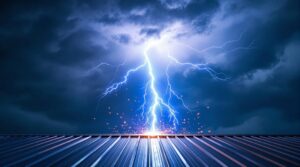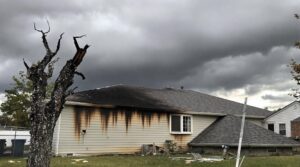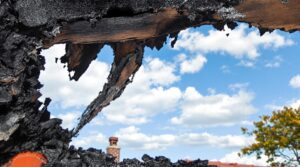After a lightning strike, homeowners should inspect their property for visible structural damage, including cracked shingles, dislodged tiles, and scorch marks on walls. Evaluating fire hazards and safety risks is also vital, as hidden fires can occur in attics, walls, and other areas. A thorough examination of the electrical system, including the panel, breakers, and appliances, is also necessary. To guarantee an extensive assessment and insurance coverage, a detailed documentation of damage and professional electrical inspection are recommended, revealing more important checks to assure safety and reliability. Homeowners should also consider contacting their insurance provider promptly to understand their policy coverage regarding lightning strikes. It’s essential to learn how to document lightning damage claims effectively, as detailed records can expedite the claims process and ensure better compensation. Additionally, maintaining a list of all affected items and photographs of the damage will help support your case and provide evidence for any necessary repairs or replacements.
Key Takeaways
- Inspect for visible structural damage to the roof, walls, and chimneys after a lightning strike to ensure the home's integrity.
- Conduct a thorough examination for hidden fires in attics, walls, and other areas to prevent further damage and safety risks.
- Assess electrical safety risks by examining the home's electrical system, focusing on compromised grounding and bonding connections.
- Check electrical panels, breakers, and appliances for burn marks, arcing signs, or melted components to identify potential fire hazards.
- Document all damage, including visible structural issues and damaged appliances, to support insurance claims and maximize settlement.
Inspect for Visible Structural Damage
Following a lightning strike, a thorough visual assessment is essential to identify potential structural damage to a building. In inspecting for visible structural damage, particular attention should be paid to the roof, where cracked shingles or dislodged tiles may indicate physical damage caused by the force of the strike. Exterior walls should also be examined for scorch marks or physical alterations, which can suggest that lightning traveled through the structure, compromising its integrity. Additionally, inspecting brick or stone chimneys for dislodged bricks or cracks can reveal lightning damage that may destabilize these structures. Prompt identification of such physical damage is vital in determining the extent of necessary repairs to restore the building's structural stability. If significant roof damage is discovered, insurance claim documentation should include detailed photos and repair estimates to support your case for coverage.
Assess Fire Hazards and Safety Risks
Following a lightning strike, evaluating fire hazards and safety risks is a critical step to prevent further damage and potential harm to occupants. The extremely high voltage discharge from a lightning strike can cause hidden fires in attics, walls, and other areas, compromising the structural integrity of the building. A thorough examination of the premises must be conducted to identify potential electrical safety risks, such as damaged wiring, appliances, and electrical systems.
Damage to Structural Integrity
In the aftermath of a lightning strike, destruction can be deceptively subtle, with structural damage often hidden from view. Homeowners must inspect the structural integrity of their property to identify potential safety risks. A thorough examination of the roof, walls, and foundation is necessary to detect any cracks or damage. Particular attention should be paid to brick or stone chimneys, as they can be destabilized by shock waves. Any sign of damage or weakness in these areas can indicate a more extensive issue. Additionally, the condition of windows and doors must be assessed, as shattered glass or warped frames can compromise security and safety. Evaluating these potential vulnerabilities is essential to guarantee the home remains a secure and stable environment.
Hidden Fire Dangers
Because the visible signs of a lightning strike can be deceiving, a thorough inspection of a home's interior is essential to identify potential fire hazards. A lightning strike can cause hidden fires in areas such as attics and walls, where sparks can ignite materials that may not be immediately visible. Electrical surges can also create hidden fires in wiring insulation or behind appliances, making a thorough inspection vital. Homeowners should monitor for unusual odors and check for signs of burnt materials, as smoke or fire can develop undetected for hours. Visible exterior damage, such as burnt or dislodged shingles and cracked windows, can also indicate internal fire risks. If any smoke or fire is detected, immediate evacuation and contacting the fire department are essential.
Electrical Safety Risks
Upon encountering a lightning strike, an essential assessment of electrical safety risks is necessary to identify potential fire hazards and prevent further damage. A thorough examination of the home's electrical system is vital, focusing on grounding and bonding connections that may have been compromised by the surge. Check all electrical outlets and devices for signs of damage, such as burn marks or melting, and guarantee all circuit breakers are functioning properly. Replace any tripped circuit breakers, as they may not reset safely. A professional electrical inspection is also recommended to assess potential hidden damage in wiring. Additionally, verify the integrity of the lightning protection system, if installed. By identifying and addressing electrical safety risks, homeowners can mitigate the risk of fire and guarantee a safe living environment.
Check Electrical Panel and Breakers
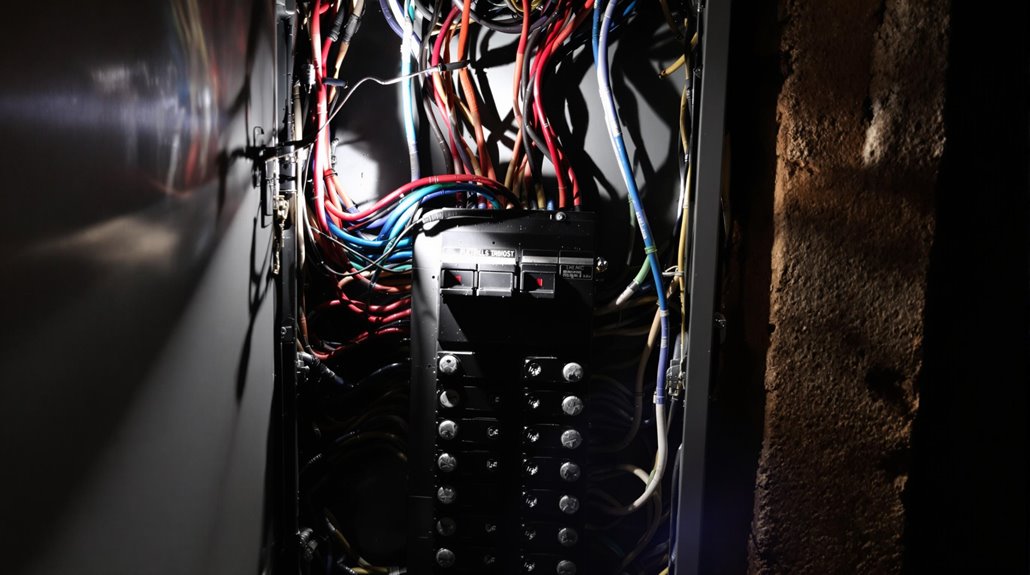
Following a lightning strike, the electrical panel and breakers require immediate inspection to identify potential damage. The panel should be visually examined for burn marks, arcing signs, or melted components, while tripped breakers should be checked carefully to determine if they have been compromised. A thorough assessment of the electrical panel and breakers is essential to verify the integrity of the grounding system and guarantee the safety and functionality of the electrical system.
Inspect for Burn Marks
An essential component of evaluating damage after a lightning strike involves inspecting the electrical panel and breakers for burn marks, which can be indicative of electrical surges. Burn marks may appear as discoloration or scorching around breakers, suggesting overheating and potential failure of the electrical components. Bus bars and terminal connections within the panel are common points for damage when lightning strikes. Public insurance adjusters can help maximize claim settlements for electrical system damage caused by lightning strikes.
| Area to Inspect | Signs of Damage | Action Required |
|---|---|---|
| Breakers | Discoloration | Document for insurance claims |
| Bus Bars | Scorched or melted | Inform professional electrician |
| Terminal Connections | Overheating | Inspect for tripped breakers |
| Panel Exterior | Charring or smoke | Investigate internal damage |
| Panel Interior | Burnt wiring | Assess electrical system integrity |
Check Tripped Breakers Carefully
The presence of burn marks on electrical panels and breakers is a clear indication of the intense heat generated by a lightning strike. Upon inspecting the electrical panel, homeowners should look for tripped breakers, which may indicate a surge or fault in the system. All tripped breakers should be replaced, even if they appear functional, as they may have been compromised by the high voltage of the lightning discharge. Signs of arcing or burnt wires within the panel also require immediate attention. Documenting any issues found within the electrical panel is crucial for insurance purposes, as thorough records can support claims related to lightning damage. By taking these steps, homeowners can guarantee their electrical system is safe and functional after a lightning strike.
Verify Grounding System Integrity
Numerous significant safety features are built into a home's electrical system to protect against electrical shock, fires, and equipment damage. A key component of this system is the grounding system, which plays an essential role in safely dissipating electrical energy, such as that from lightning strikes.
| Grounding System Component | Inspection Tasks |
|---|---|
| Grounding Electrodes | Verify electrode integrity and connections. Confirm compliance with current codes. |
| Ground Fault Circuit Interrupters | Inspect for physical damage and burn marks; replace units even if seemingly functional. |
| Electrical Panel | Check for tripped breakers, arcing signs, and physical damage; schedule a professional evaluation if issues are found. |
Inspecting and verifying the grounding system integrity after lightning strikes will guarantee safety, and minimize future risk.
Examine Appliances and Electronics
Following a lightning strike, a thorough examination of appliances and electronics is vital to assess potential damage and prevent further hazards. All devices should be unplugged to protect against residual surges that can occur even after the storm has passed. Appliances such as televisions, refrigerators, microwaves, dishwashers, and stoves are particularly vulnerable to surge damage and should be inspected for burn marks on plugs, melted components, or signs of malfunctioning. Utilizing an outlet checker can help identify if arcing or electrical surges have compromised outlets, leading to hazardous wiring conditions. Documenting any observed damage to appliances is important for insurance purposes, as coverage typically includes lightning-related damages when properly reported. This examination guarantees a safe and functional living environment.
Identify Signs of Hidden Damage
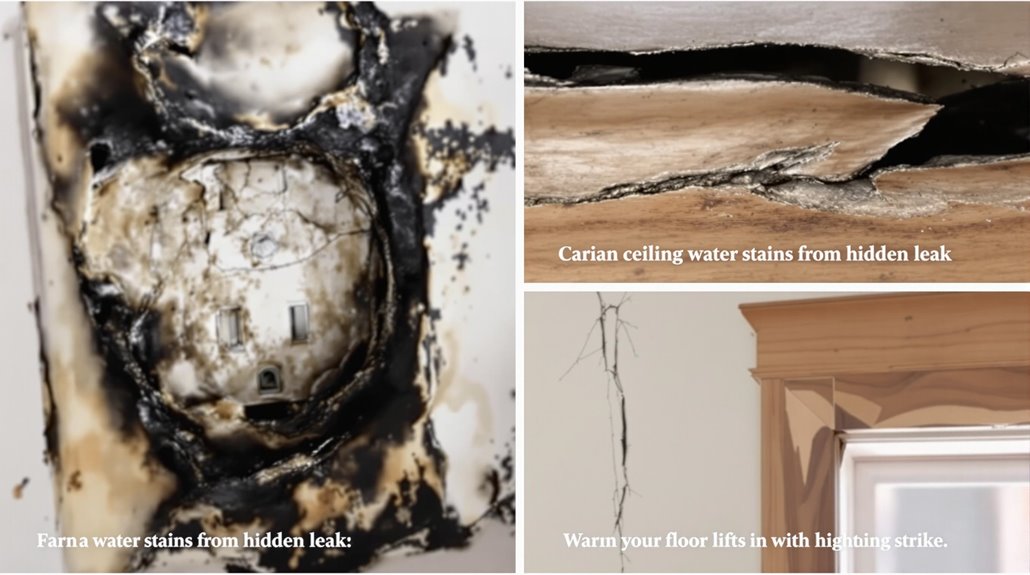
Following a lightning strike, it is vital to identify signs of hidden damage that may not be immediately apparent. Inspection of the roof and walls is essential to detect potential breaches in the structure's integrity, while checking electrical systems can reveal concealed damage caused by power surges. Burn marks, in particular, can indicate areas where electrical arcing has occurred, necessitating further investigation to determine the extent of the damage.
Inspect Roof and Walls
A thorough examination of the roof and walls is critical after a lightning strike, as the electrical surge can cause significant damage that may not be immediately visible. Inspecting the roof for cracked shingles, dislodged tiles, or burn marks can indicate direct damage from the electrical surge. Walls should also be checked for signs of scorch marks or stains, which may suggest hidden fires.
Key Areas to Inspect:
- Roof Condition: Look for cracked shingles, dislodged tiles, or burn marks that can indicate direct damage.
- Wall Damage: Check for scorch marks or stains that may suggest hidden fires.
- Attic and Ceiling: Conduct a thorough inspection for hidden fires or damage that may not be immediately visible from the exterior.
Check Electrical Systems
Numerous electrical system components are susceptible to damage from a lightning strike, with the full extent of destruction not immediately apparent. A detailed inspection is important to identify hidden damage and guarantee a safe living environment. GFCI outlets should be checked for functionality, as they often fail during a lightning strike. Circuit breaker boxes should be inspected for signs of arcing, and megger tests can be used to detect insulation breakdown in branch circuits. Flickering lights, melting outlets, and malfunctioning appliances can signal hidden electrical issues. Documenting these issues is essential for insurance claims and necessary repairs. A thorough visual inspection of all wiring throughout the home is crucial, as lightning can cause damage behind walls or in attics. Inspecting electrical systems is a key step in evaluating overall damage.
Look for Burn Marks
Inspecting electrical systems for damage after a lightning strike is only the first step in evaluating overall damage. After confirming the integrity of electrical infrastructure, inspecting areas around outlets and electrical panels for burn marks is essential in identifying potential hidden damage.
Burn marks can be signs of severe electrical surges, indicating compromised electrical components. The following are key areas to inspect for burn marks:
- Discoloration on walls and ceilings: Charring near appliances can indicate electrical problems that aren't visible.
- Wiring insulation: Damaged insulation poses a fire hazard within walls.
- GFCI outlets: Compromised outlets may be rendered ineffective after a lightning strike.
Document any discovered burn marks for reporting to your insurance policies, helping to guarantee thorough and precise claims for needed repairs following a lightning strike.
Evaluate Grounding and Bonding Systems
Following a lightning strike, nearly all aspects of a building's electrical infrastructure warrant scrutiny, with grounding and bonding systems being of paramount importance. This examination involves inspecting grounding electrodes and conductors for visible signs of damage to prevent electrical fires and equipment failure.
| Grounding System Components | Visible Signs of Damage | Action Required |
|---|---|---|
| Grounding Electrode | Cracks or burn marks | Replace if damaged |
| Grounding Conductor | Fraying or cuts | Replace if damaged |
| Bonding Connections | Looseness or corrosion | Tighten or replace |
| Breakers | Tripped or malfunctioning | Replace regardless of test results |
| Coaxial Connections | Burn marks or damage | Inspect and replace if necessary |
Test GFCI Outlets and Circuits
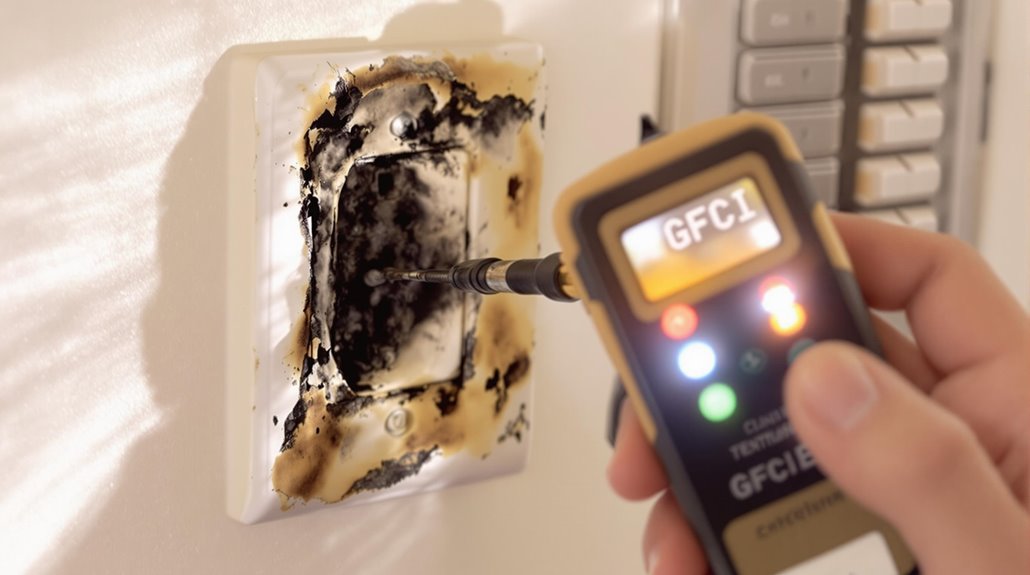
The integrity of a building's electrical infrastructure extends beyond grounding and bonding systems, as lightning strikes can also compromise the functionality of Ground Fault Circuit Interrupter (GFCI) outlets and circuits. During an electrical inspection, testing these components is essential to guarantee they are functioning correctly and safely.
To test GFCI outlets effectively:
- Press the "Test" button: Verify that the outlet trips and cuts off power. If it fails to reset or function, it must be replaced immediately.
- Inspect for visible damage: Check for signs of burn marks, melting, or other damage that could indicate the outlet was compromised during the lightning event.
- Test all GFCI circuits: Perform this testing on all GFCI outlets in the home, especially those connected to outdoor or wet areas.
Inspect Roofs, Windows, and Doors
Numerous structural elements of a building can be compromised in the aftermath of a lightning strike, necessitating a thorough examination of roofs, windows, and doors to identify potential damage. After a home has been lightning struck, inspect roofs for cracked or blown-off shingles, as the strike can cause significant structural damage that may lead to leaks. Windows should be checked for shattered glass or cracks, indicating a pressure wave destabilized their integrity. Burn marks or scorch marks around windows and doors can suggest electrical surges or fires. Verify doors open and close properly, as warped frames or welded contacts can compromise functionality. A thorough chimney inspection is also essential to identify dislodged bricks or structural damage.
Document Damage for Insurance Claims
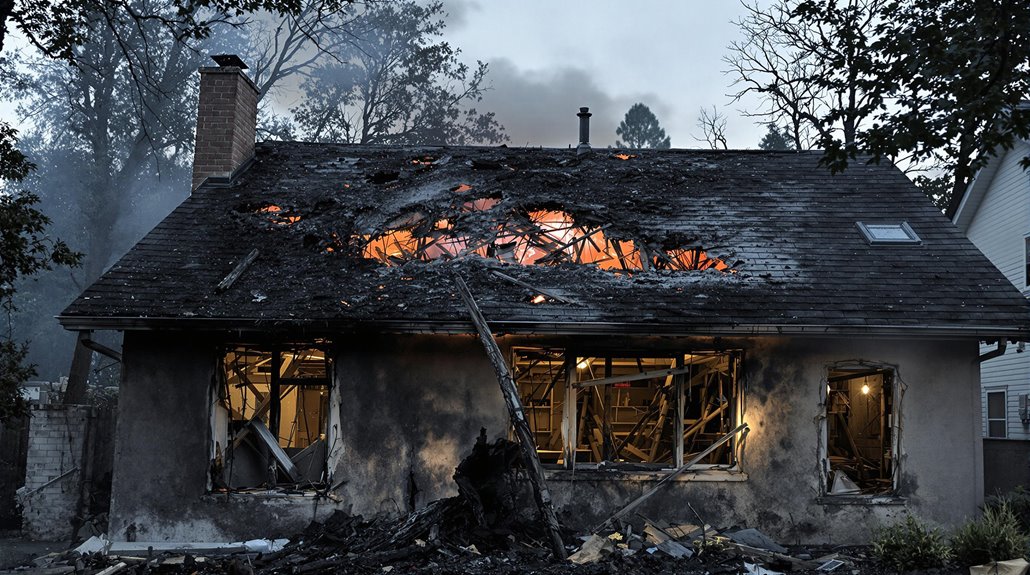
Once potential hazards have been identified through a thorough examination of the property's structural elements, attention should turn to thoroughly documenting all visible damage for insurance purposes. This step is vital in ensuring a smooth and efficient claims process with the insurance company. To document damage effectively, the following steps should be taken:
- Photograph all damage: Take clear and detailed photographs of all damaged areas, including appliances, electrical systems, and structural issues.
- Create a detailed list of damaged items: Record the make, model, and estimated replacement costs of all damaged items to support the insurance claim.
- Record relevant details: Note the date and time of the lightning strike, as well as any relevant weather conditions, to establish a timeline for the insurance claim documentation.
Working with a public insurance adjuster can help maximize your settlement amount while ensuring all damage is properly documented and evaluated.
Schedule a Professional Electrical Inspection
Following a lightning strike, it is highly advisable to schedule a professional electrical inspection to assess potential damage to the electrical system. A qualified electrician can identify hidden issues not visible during a casual check, guaranteeing the safety and integrity of the electrical system.
| Inspection Focus | Description |
|---|---|
| Megger testing | Detects insulation failures in branch circuits. |
| Grounding electrodes | Verifies condition and integrity of critical components. |
| Breaker panel inspection | Checks for tripped breakers, arcing, and burn marks. |
Replacing damaged Ground Fault Circuit Interrupters (GFCIs) is also recommended to prevent electrical shock. A professional electrical inspection provides peace of mind, knowing that potential hazards have been identified and addressed to guarantee a safe living environment. This expert assessment helps homeowners prioritize necessary repairs.
